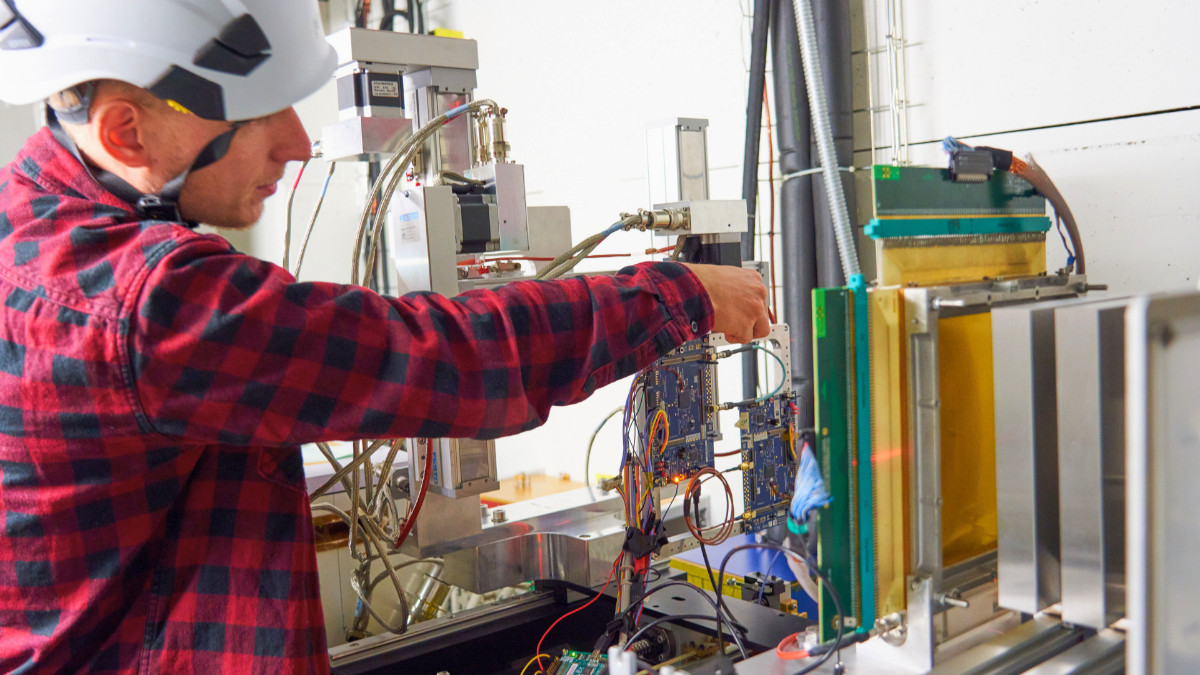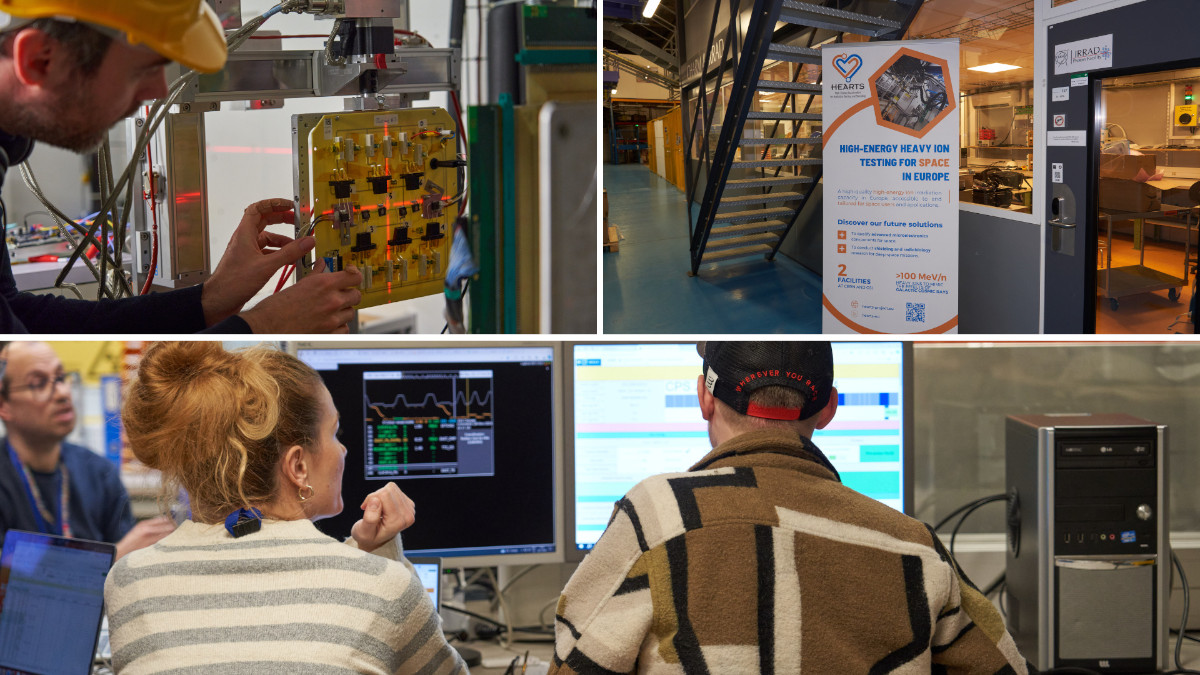For two weeks in November, 10 companies and institutions were provided access to CERN’s new high-energy heavy ion irradiation facility to test electronics for use in space, with positive initial feedback from the users.

Making adjustments to the HEARTS@CERN radiation testing set up during the user pilot campaign at the IRRAD facility at CERN (Image: CERN).
The EU-funded HEARTS project has marked a significant milestone in its efforts to boost Europe’s capabilities in testing electronics for use in space after the successful completion of its user pilot campaign, which took place at CERN during the second half of November.
In total, 10 companies and institutions spent a combined 150 hours testing electronic components and modules for a variety of uses in space, blasting them with very high-energy lead beams at the recently developed HEARTS@CERN facility.
The HEARTS (High-Energy Accelerators for Radiation Testing and Shielding) project is aiming to establish two new radiation testing facilities for space applications, one at CERN and the other at the GSI Helmholtz Centre for Heavy Ion Research in Germany.
The goal of the November pilot user run was to demonstrate the readiness of CERN’s facilities for routine space electronics testing. This included six user teams from private companies external to the HEARTS consortium, an important way of finding out to what extent it is possible to meet the testing requirements of industrial users.
What is unique about the efforts of the HEARTS project is its goal to allow external, private companies to use unique facilities at CERN and GSI that normally prioritise use for purely scientific purposes.
With Europe aiming to increase its capabilities in aerospace in important areas such as communication, navigation, weather forecasting, environmental monitoring, as well as space-based research and exploration, CERN and GSI could play an important role in boosting the continent’s space radiation testing capabilities.
While other facilities in Europe offer radiation tests, CERN and GSI are the only places capable of producing heavy ion beams at very high energies, meaning that electronic components or devices can be penetrated with radiation at far greater depths and with far heavier an ion – in CERN’s case lead. Having this penetration depth is vital for testing certain electronic components used for space applications. Currently, many European companies are reliant on the NASA Space Radiation Laboratory (NSRL), based at Brookhaven National Laboratory in the US, to test in these conditions.
Positive feedback for HEARTS’ pilot test campaign
While the 10 user teams are still analysing the data they obtained during the run, the initial feedback has been largely positive.
European aerospace corporation Airbus, a member of the HEARTS consortium, was one company that used the facility during the campaign to test power diodes and memory chips for general purpose use in their space-bound products. These components had already been radiation tested and characterised at other facilities, with the tests at CERN acting as a way to gauge the potential of the facility for future use.
Even though the facility is still in the early stages of reaching its potential in terms of radiation testing, Airbus sees a strong interest in its development.
“For space applications, if you cannot test a device, you cannot get it in the air,” said Renaud Mangeret, Airbus radiation effects expert. “The HEARTS set-up provides unique testing capabilities, allowing users to expose components to very-high-energy heavy ions. We do not need such conditions for all of our testing needs, but for those that we do need them for, the CERN facility offers good potential.”
Mynaric, a manufacturer of laser communication equipment for airborne and spaceborne communication networks, was one of the six companies external to the HEARTS project participating in the pilot test run.
A team from the company tested various electronic modules for their spaceborne optical communications terminals for satellites in low Earth orbit. They said that the opportunity to test at low flux capabilities was especially important given that such testing reduces the chance of error pile-up and helps assess how a component or module will perform under long-duration, low-flux radiation exposure.
“We executed on all the tests we had planned, with the set up as expected. Everything went smoothly and the flux was in the expected range,” the Mynaric team said, satisfied despite finishing at 04:00 in the morning. “The fact that CERN could facilitate running over time was also a positive,” the team added.
They also praised the responsiveness and efficiency of the HEARTS project in approving their request for test time, saying it was highly convenient to be able to book the slot at a facility close by.
“It’s hugely important to have testing facilities like this here in Europe,” the team said. “In fact, there should be more – having a test window of just three weeks every year is too little,” said S.R. Kulkarni of the Mynaric team. “If Europe and the European Union wants to maintain its position as a leading sponsor and supporter of proliferated spaceborne communication networks, connected by ever more satellites, then more testing capabilities really are needed.”

Table showing the properties of the beam offered by the HEARTS@CERN facility. Beam flux: 10² – 10⁵ ions/cm²/spill, with spills lasting 1s and repeating every ~10s. Beam size: square beam of side 25, 50 or 75 mm (Image: CERN).
TESAT, a German company operating in the fields of telecommunication payloads for satellites and laser communications, also reported being satisfied with their testing experience.
“For the first ever user campaign, it went really well,” the team said. “The CERN team really supported us, they were very flexible and responsive and took care of everything.”
TESAT pointed out certain improvements that could be made to the set up in the HEARTS@CERN facility, for example to the laser positioning system and control of the flux. They also reported some difficulties with Swiss customs, meaning they could not bring everything they wanted.
“So, some small elements need to be updated, but overall it was a positive experience.”
The TESAT team noted the importance of what the HEARTS project is aiming to achieve for Europe’s capabilities and sovereignty in terms of space.
“It is becoming more important, technologically and politically, to have high penetration range testing for space applications in Europe,” the team said. “Right now, the NSRL in the US is the gold standard. But as a European user, it is difficult to get time at NSRL, so a similar offering in Europe would be vital.”
The next steps for HEARTS
The completion of the user pilot campaign this year at CERN marked an important step for the HEARTS project and provided valuable insight into learning what is needed to support scientific and industrial users going forwards.
“The pilot user campaign has been an enormous challenge but working directly with exigent and experienced radiation effects testing users has been the best possible way to rapidly improve and assess our readiness level, both in terms of technical and service performance,” said HEARTS project coordinator Rubén García Alía. “It has been a unique endeavour, requiring a huge team effort across multiple groups at CERN.”
Natalia Emriskova, a radiation physicist and engineer at CERN who works on the HEARTS project and who served as the user run coordinator, said that the test campaign was very beneficial for taking the project forwards.
“This very first HEARTS@CERN user run required a great deal of preparation, coordination and planning, as well as a lot of dedication from the whole HEARTS team and members of other teams across CERN who supported us,” she said. “We made a big leap forward in the project and are very proud of it. Overall, the run went smoothly, we managed to follow the schedule and efficiently use all the lead ion beam we could have this year. A few things can still be improved, and to this end it is very helpful to receive real application feedback from testing users who also experienced other well-established facilities. I feel very optimistic to put this feedback into place and do even better next year!”
Going forwards, HEARTS@CERN aims to offer a hybrid access scheme to its testing facilities to cater for industrial needs through proprietary testing and to scientific needs, with scientific users able to apply for test time through calls put out by RADNEXT, an EU project supporting transnational access to irradiation facilities.

